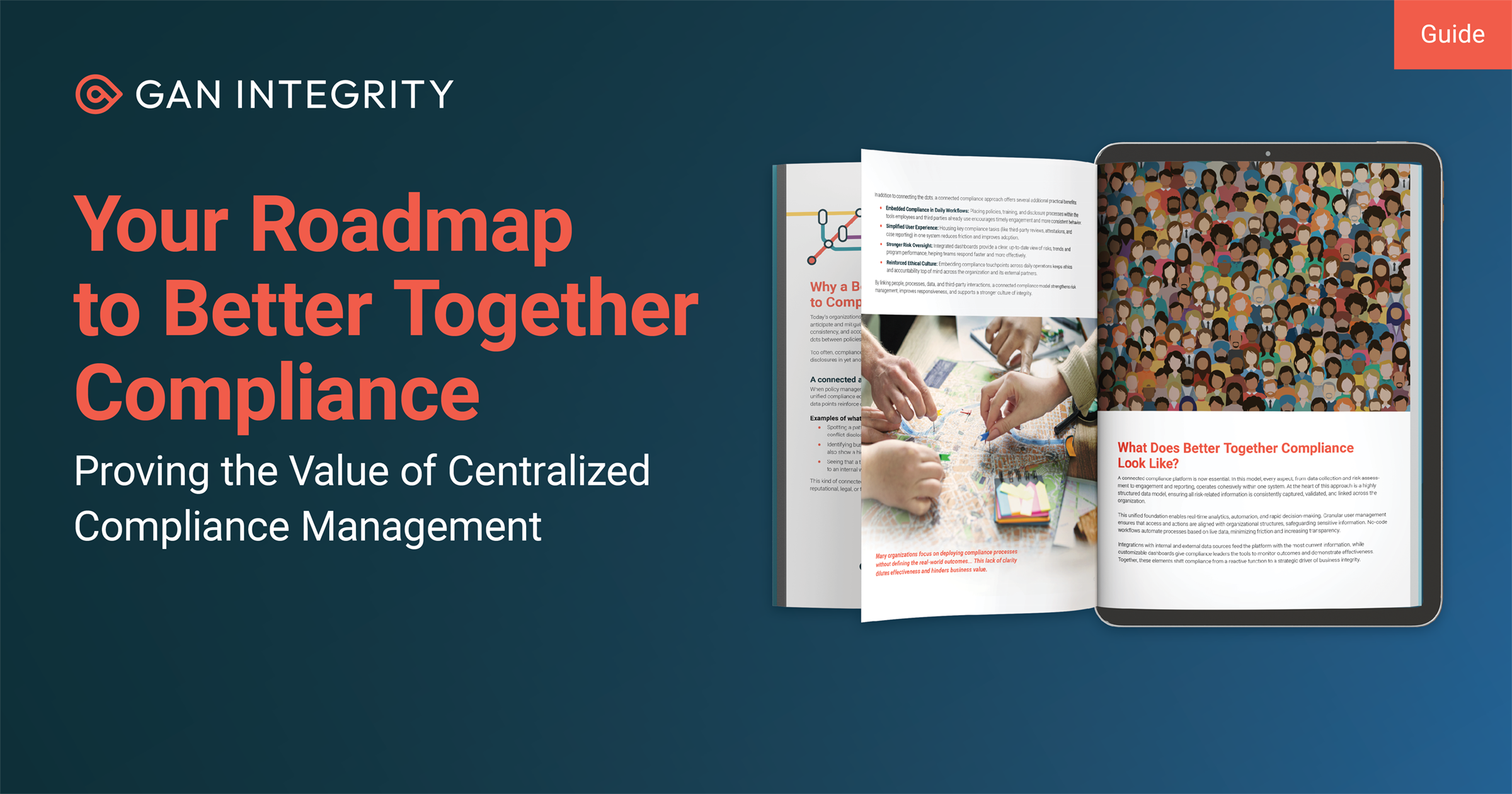In today’s fast-moving, interdependent world, third-party risk isn’t a static issue. One day, a vendor operates well within your risk appetite; the next, they’re caught up in a regulatory investigation, geopolitical disruption, or ESG controversy that never showed up in their last due diligence. What changed?
The answer is often “risk drift”—the phenomenon where a third party’s risk profile gradually shifts over time, often unnoticed, until a previously acceptable relationship becomes a liability.
As organizations increase reliance on external partners to drive innovation and efficiency, risk drift has quietly become an organizational blind spot in third-party risk management (TPRM). But while the threat may evolve slowly, the consequences tend to arrive suddenly and publicly—from reputation risk and brand damage to regulatory fines and supply chain shutdowns.
Your reputation is no longer defined solely by your own actions. It is shaped—sometimes undermined—by the behaviors, ethics, and resilience of third parties operating across your value chain. That makes risk drift not only a compliance issue, but a strategic and reputational one.
Consider Dior. The luxury brand faced global backlash after allegations emerged that one of its Italian subcontractors had engaged in illegal hiring and imposed exploitative “sweatshop” conditions. The controversy didn’t stem from Dior’s internal operations—it originated in the practices of a third party buried deeper in the supply chain. Despite passing standard due diligence, the risk profile of this subcontractor had silently drifted. Dior’s brand equity took the hit.
This incident highlights the painful truth: reputational harm today often originates from third parties, even when there’s no direct legal breach. Customers, investors, and regulators no longer distinguish between your company and those you work with. Risk drift transforms a distant compliance issue into a boardroom crisis, fast.
What Is Risk Drift?
Risk drift is the gradual and often unmonitored change in a third party’s risk profile. Unlike an acute risk event, risk drift is subtle. It doesn’t trip alarms. It builds. And unless you’re actively looking for it, you may not notice until it’s too late.
Risk drift can occur for a variety of reasons:
- A supplier expands into higher-risk jurisdictions.
- Ownership changes lead to new governance structures.
- Financial stability weakens due to economic downturns.
- A vendor’s own third parties introduce unknown risks.
- Social, ethical, or environmental controversies emerge.
These changes can combine and compound—quietly escalating the third party’s exposure to reputational, operational, or compliance risks.
But risk drift is not always a bad thing. A third party may expand into new markets, improve governance practices, or evolve its operations in ways that reduce risk. The key is knowing when and how that drift is occurring. A solid TPRM strategy allows you to stay ahead of those changes: adapting your oversight to match reality, rather than reacting to surprises.
Worse, the nature of risk drift means that legacy due diligence or onboarding assessments no longer reflect reality. Without mechanisms to detect those shifts, organizations are left managing yesterday’s risks while today’s risks grow unchecked.
The Value of Early Warning Signs
One of the most compelling reasons to evolve your TPRM strategy is the ability to act on risk indicators before they escalate. Early warning signs are often hidden in open-source intelligence—if you know where to look.
Take the example of Funnull Technology Inc. In January 2025, security researchers and media outlets began reporting on the company’s deep involvement in infrastructure laundering, fake trading apps, and hosting scam websites. Despite these red flags, Funnull wasn’t sanctioned by the U.S. government until May 29, 2025.
For nearly six months, organizations relying solely on sanctions lists or static compliance checks would have had no formal reason to reconsider their relationship with Funnull. But those leveraging continuous adverse media monitoring would have seen the warnings much earlier—long before the official designation.
What if a company had signed a contract with Funnull in March 2025, unaware of the accumulating risk signals? The outcome could include reputational fallout, legal exposure, or the operational burden of unwinding a sanctioned relationship.
Now consider the alternative: a TPRM program that surfaces and flags adverse media in real time. That organization could have:
- Initiated deeper due diligence.
- Engaged internal stakeholders early.
- Decided to delay or cancel the engagement altogether.
Early risk signals create time. Time to investigate. Time to escalate. Time to choose a safer path.
In a world where regulatory and reputational consequences move fast, early visibility isn’t just a competitive advantage, it’s a reputational imperative.
Why Traditional TPRM Frameworks Struggle to Catch It
Most legacy TPRM approaches are built around point-in-time assessments: conduct due diligence at onboarding, maybe refresh it once a year, and flag any anomalies during contract renewal. But that cadence assumes third-party risk is relatively stable—it’s not.
Risk drift exposes a systemic design flaw: too many TPRM programs are calibrated for compliance, not change. They emphasize policies and controls but lack the agility to anticipate dynamic shifts in the risk landscape.
Here’s where the cracks appear:
- Siloed risk data: Information on supplier performance, compliance flags, and external risks often live in disconnected systems, which makes it difficult to identify patterns or escalating concerns.
- Lack of continuous monitoring: Most firms lack real-time visibility into third-party behavior or public perception, allowing minor concerns to snowball unnoticed.
- Static risk appetite: When risk tolerance is defined in policy but not reinforced in practice, decision-making becomes inconsistent or reactive.
- Poor cross-functional collaboration: Procurement, legal, compliance, and business owners each manage different parts of the relationship—often without a unified risk view.
Ultimately, this creates a governance gap. You may think a relationship is low-risk because the last risk assessment said so—but the ground has shifted. Without proactive controls, what was once an acceptable risk can quietly drift into exposure for your organization's business operations and reputation.
Real-World Consequences of Risk Drift
Risk drift doesn’t always lead to crisis—but when it does, the fallout is fast and unforgiving. Recent industry examples show how reputational and operational damage can come from third parties that no longer align with your standards:
- Unnoticed ethical lapses: Fashion brands have suffered backlash after investigative reports linked their third-tier subcontractors to illegal labor conditions—issues missed due to overreliance on tier-one assessments.
- Misaligned ESG values: Companies have faced protests or investor criticism due to suppliers with weak environmental practices, even when no formal breach occurred.
- Cyber threats through third parties: Attackers increasingly exploit third-party access as a backdoor into enterprise networks. One missed vulnerability in a vendor’s tech stack can compromise an entire ecosystem.
In each case, the initial signs were there—buried in operational data, adverse media, or internal systems. But without visibility, organizations couldn’t respond until the risks surfaced externally—when the damage was already done.
How to Identify and Address Risk Drift Early
Risk drift can’t be eliminated—but it can be managed. Leading organizations are rethinking their TPRM strategies to move from static oversight to continuous resilience. That shift starts with three core capabilities: Connect. Anticipate. Govern.
1. Connect the right information
The first step in managing risk drift is improving the quality and completeness of risk information.
That means not just pulling external data sources—but strengthening your internal signal intelligence: - Incident data, employee disclosures, and policy exceptions often reveal underlying issues with third parties before they escalate into headlines. - Category managers may have unstructured insights from the field—such as late payments to subcontractors or repeated delivery failures. - Procurement and commercial teams may know about behavioral red flags that never make it into the formal due diligence process.
Externally, integrating adverse media, litigation data, beneficial ownership changes, and sanctions screening helps build a holistic picture.
When information is siloed or partial, the risk profile is distorted. But when it’s connected across systems and functions, you gain a living, multidimensional view of third-party health—based on what’s happening, not just what’s documented.
2. Anticipate changes before they escalate
Once data is connected, the next step is designing processes that detect movement—not just compliance.
High-performing TPRM teams use:
- Dynamic risk scoring models that update with new data, triggering alerts when thresholds are crossed.
- Continuous monitoring of public sentiment, litigation, regulatory enforcement, and ESG news.
- Early engagement with sourcing and commercial teams to vet partners well before onboarding.
This isn’t just about automation, it’s about timing. If you detect an issue during contract renewal, you’re behind. But if you catch it at sourcing, you have options.
Proactive due diligence upfront allows you to “plot a safe path” forward. That foresight is essential when navigating high-risk regions, critical suppliers, or fast-moving geopolitical shifts.
3. Govern with clear accountability and agility
Finally, a well-governed TPRM program ensures that when risk drifts, someone is responsible for catching it—and knows what to do next.
That requires:
- A clear definition of risk appetite tied to decision thresholds (e.g., when to escalate, offboard, or remediate).
- Cross-functional committees or escalation workflows for managing high-impact decisions, especially when risks span domains (e.g., cyber + reputational + legal).
- Defined offboarding protocols that include data transfer, access revocation, and communication planning.
Most importantly, governance must be fit for purpose. If your third-party universe is large and low-risk, governance can be leaner. But if you manage a small number of high-risk, high-impact vendors governance needs to be deliberate, responsive, and embedded in day-to-day workflows.
From Reactive to Resilient
Risk drift is a quiet risk. It doesn’t flash on dashboards or headline reports, until it does. And when it surfaces, it often reveals more than a third party problem, it exposes a program problem.
TPRM programs rooted in point-in-time due diligence are inherently limited. Today’s risk environment demands more than compliance—it demands continuous awareness, contextual understanding, and shared accountability.
At GAN Integrity, we believe modern TPRM must help organizations:
- Detect shifts early.
- Respond with speed and context.
- Embed governance across the third-party lifecycle.
The goal isn’t just to manage third parties—it’s to stay resilient in a world where risk is always in motion.
If risk drift has become your hidden challenge, it’s time to realign your TPRM strategy for the reality you operate in—not the one you assessed a year ago.

Colin Campbell is Gan Integrity's Strategic Product Marketing and Analyst Relations leader with over 15 years of experience in the SaaS software and tech industry. Colin has led analyst relations and product marketing growth strategies in North America, EMEA, UK and APAC, growing revenues in multiple industries. At GAN Integrity, Colin drives market expansion, demand generation and significantly enhancing customer retention, with a talent for aligning marketing strategies with business goals to deliver results.
